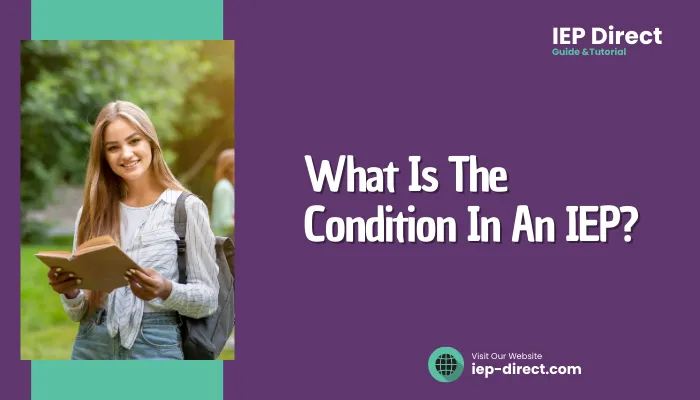What Is The Condition In An IEP Direct? It is vital to comprehend the condition that a child’s IEP Direct indicates for anyone involved in their education.
Any condition cited in an Individualized Education Program (IEP) essentially refers to the specific disability or impairment that makes a student eligible to receive special education services. This is because it forms the basis of an entire IEP.
In this blog we will discuss everything in detail so buckle up your seat and let’s deep down in it.

What Is The Condition In An IEP : Learning Plan
Have you ever thought what is the condition in an IEP? nope? don’t worry I got you.
It is crucial to understand what this condition listed in the child’s Individualized Education Program (IEP) means for all those who are concerned about his or her education.
The article will discuss what does “condition” mean in relation to an individualized education plan, how it is used to create personalized learning plans, and why it becomes one of the important foundations for learning for students.
A Condition’s Role In An IEPs
A “condition” recorded within an IEP denotes any particular disability or impairment that entitles such learners to be placed under special education care. This forms the whole groundwork upon which any other aspect of this plan rests.
The Importance Of Conditions In IEPs
The condition described as a roadmap on an Individualized Education Program (IEP) leads children through their course of study. Thereby, knowing conditions provides support.
These resources could be useful for:
- Tailored Education: Students’ conditions differ due to their individuality. Knowing the exact condition won’t let them go astray from designing instruction materials aiming at their peculiarities.
- Effective Communication: Understanding the condition helps foster better communication among parents, teachers, and other professionals involved in the student’s life.
- Access to Resources: There are various resources for different conditions. Recognizing it makes certain that a young person gets necessary support.
Understanding the condition ensures tailored education, effective communication, and access to the right resources for student success.
Common Conditions In IEPs
Although the list of conditions that qualify a student for special education is vast, some ones are more common than others.
Here are a few examples:
- Learning Disabilities: They affect how children process information. Examples include dyslexia, dyscalculia, and auditory processing disorder.
- Speech and Language Impairments: Difficulty with communication whether verbal or written.
- Intellectual Disabilities: These entail significant limitations in intellectual functioning as well as adaptive behavior.
Recognizing common conditions ensures effective support and tailored strategies for special education success.
Collaboration In IEPs
This calls for collective efforts from parents, teachers, special educators’ providers, and any other relevant parties aiming at fully comprehending learners’ conditions so as to design plans tailored specifically to meet their respective needs.
Remember: The condition is only a piece of the puzzle. When planning an IEP, it is important to consider the students’ weaknesses, strengths, as well as their personal likes and dislikes.
Therefore, Working together with parents, teachers, and other parties involved can help meet every student’s needs in a unique manner.
Types Of Conditions In An IEP
Now that we have known what is the condition in an IEP, now it’s time to know about types of condition in IEP.
A proper education plan for students must be tailored according to specific conditions outlined in their respective IEPs.
The section will examine various kinds of conditions typically found in IEPs and how they affect the student’s journey of learning.
Medical Conditions Affecting Education
Many medical problems can greatly impair a child’s capacity to learn or participate fully in school activities. Some special accommodations and support services must be added to such programs as part of the Individualized Education Plan (IEP).
Below are the three main condition on which you should focus the most:
Common Medical Conditions In IEPs
Explore common medical conditions impacting IEPs for better support
For example:
- Physical Disabilities: These are conditions like cerebral palsy, muscular dystrophy, or spinal cord injuries that might affect mobility, fine motor skills, and sensory processing.
- Chronic Illnesses: For instance, asthma may lead to absence from lessons coupled with fatigue or difficulty concentrating on one thing at a time.
- Sensory Impairments: Vision or hearing loss can greatly hinder a learner. IEPs for students with these disabilities normally entail assistive technology.
Therefore, Addressing these conditions helps tailor IEPs to meet specific needs.
Behavioral Conditions And IEPs
Behavioral conditions can significantly affect the learning ability of a student and their interaction with peers. To this end, such difficulties have to be addressed in order to create a supportive distance on campus.
Common Behavioral Conditions
Understanding common behavioral conditions like ADHD and ASD helps tailor IEPs with effective behavior management and support strategies.
- Attention Deficit Hyperactivity Disorder (ADHD): Difficulty paying attention, controlling impulsive behavior, and staying still.
- Oppositional Defiant Disorder (ODD): Pattern of angry, irritable, and defiant behavior.
- Conduct Disorder: Persistent pattern of aggressive and rule-breaking behavior.
- Emotional Disturbance: Difficulty managing emotions, behavior, or relationships.
- Autism Spectrum Disorder (ASD): Challenges in social interaction, communication, and repetitive behaviors.
Therefore, IEPs for children with behavioral diagnoses often include behavior management plans alongside social skills training plus counseling services.
Identifying the unique struggles of students with diverse conditions enables teachers to offer support or adjust curriculum materials towards achieving their full potential through targeted assistance.
Customized Education To Individual Needs
It is important to have knowledge about any condition mentioned in an individualized education plan if it is going to be useful at all in terms of planning effectively for students.
Understanding what the condition in an IEP entails is crucial, as this part delves into how different kinds of learners’ conditions influence IEP goals, including modifications through which they are written up, as well as its development process.
The Role Of Conditions
At the IEP, accommodations and modifications play an important role in enabling students with disabilities to access the general curriculum and attain their objectives.
The specific needs for accommodations and modifications vary depending on what is the condition in an IEP for each student.
Examples Of Accommodations And Modifications
Explore examples of accommodations and modifications tailored for students with disabilities across various categories.
| Category | Accommodations | Modifications |
|---|---|---|
| Students with Learning Disabilities | Extended time on tests, assistive technology, preferential seating | Adapted curriculum, reduced workload |
| Students with Physical Disabilities | Adapted equipment, assistive technology, accessible seating | Modified physical education requirements, adapted assignments |
| Students with Emotional Disturbances | Flexible grading, frequent breaks, behavior management plans | Adapted social skills curriculum, reduced class size |
Understanding these accommodations and modifications can significantly enhance educational support for students with disabilities.
The Impact Of Conditions
A student’s educational goals and objectives need to be individualized to suit the unique needs of a learner with a disability. Such targets are influenced by the condition since it determines what is appropriate or attainable in this case.
Key Considerations
Focus on these key considerations to effectively support students’ educational progress and overall development.
| Category | Description |
|---|---|
| Student Strengths | This will involve capitalizing on the student’s strengths over their weaknesses. |
| Functional Skills | These should emphasize independent living skills and full participation in community life. |
| Individualized Approach | Make sure that you develop goals that are SMART – specific, measurable, achievable, relevant, and time-bound. |
| Progress Monitoring | Regular checks can then be conducted to establish if the student is moving towards their goals based on which adjustments can be made as necessary. |
Implementing these strategies ensures that students achieve their educational goals and thrive in their communities.
Collaboration And Communication
Collaboration and communication between parents, educators, and other specialists are essential in developing an effective IEP tailored to a student’s specific condition. Everyone who is involved should share their perspectives on the learner’s requirements so that an agreement can be reached on the best way forward.
Communication Strategies
- Regular Meetings: Consistent meetings to discuss progress and make adjustments as needed.
- Parental Input: Incorporating parents’ observations and concerns into the IEP plan.
- Interdisciplinary Approach: Collaboration among general education teachers, special education teachers, and therapists.
This ensures that all relevant voices contribute towards creating a learning environment tailored for each student.
Conclusion
We have covered what is the condition in an IEP. The development of an IEP is an ongoing journey that requires continuous collaboration, communication, and adaptation.
By understanding the condition in an IEP and working together, educators, parents, and specialists can create a comprehensive and individualized plan that supports the student’s growth and success.
